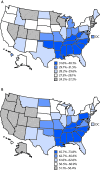Prevalence of Self-Reported Hypertension and Antihypertensive Medication Use Among Adults Aged ≥18 Years - United States, 2011-2015
- PMID: 29470459
- PMCID: PMC5858041
- DOI: 10.15585/mmwr.mm6707a4
Prevalence of Self-Reported Hypertension and Antihypertensive Medication Use Among Adults Aged ≥18 Years - United States, 2011-2015
Abstract
Hypertension, which affects nearly one third of adults in the United States, is a major risk factor for heart disease and stroke (1), and only approximately half of those with hypertension have their hypertension under control (2). The prevalence of hypertension is highest among non-Hispanic blacks, whereas the prevalence of antihypertensive medication use is lowest among Hispanics (1). Geographic variations have also been identified: a recent report indicated that the Southern region of the United States had the highest prevalence of hypertension as well as the highest prevalence of medication use (3). Using data from the Behavioral Risk Factor Surveillance System (BRFSS), this study found minimal change in state-level prevalence of hypertension awareness and treatment among U.S. adults during the first half of the current decade. From 2011 to 2015, the age-standardized prevalence of self-reported hypertension decreased slightly, from 30.1% to 29.8% (p = 0.031); among those with hypertension, the age-standardized prevalence of medication use also decreased slightly, from 63.0% to 61.8% (p<0.001). Persistent differences were observed by age, sex, race/ethnicity, level of education, and state of residence. Increasing hypertension awareness, as well as increasing hypertension control through lifestyle changes and consistent antihypertensive medication use, requires diverse clinical and public health intervention.
Conflict of interest statement
No conflicts of interest were reported.
Figures
References
-
- Benjamin EJ, Blaha MJ, Chiuve SE, et al. ; American Heart Association Statistics Committee and Stroke Statistics Subcommittee. Heart disease and stroke statistics—2017 update: a report from the American Heart Association. Circulation 2017;135:e146–603. 10.1161/CIR.0000000000000485 - DOI - PMC - PubMed
-
- Chobanian AV, Bakris GL, Black HR, et al. ; Joint National Committee on Prevention, Detection, Evaluation, and Treatment of High Blood Pressure. National Heart, Lung, and Blood Institute; National High Blood Pressure Education Program Coordinating Committee. Seventh report of the Joint National Committee on Prevention, Detection, Evaluation, and Treatment of High Blood Pressure. Hypertension 2003;42:1206–52. 10.1161/01.HYP.0000107251.49515.c2 - DOI - PubMed
-
- Fryar CD, Ostchega Y, Hales CM, Zhang G, Kruszon-Moran D. Hypertension prevalence and control among adults: United States, 2015–2016. NCHS data brief, no 289. Hyattsville, MD: US Department of Health and Human Services, CDC, National Center for Health Statistics; 2017. - PubMed
MeSH terms
Substances
LinkOut - more resources
Full Text Sources
Other Literature Sources
Medical


